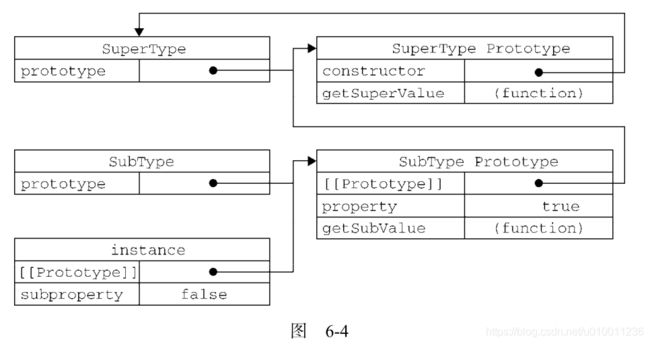《JavaScript高级程序设计(第3版)》第6章 面向对象的程序设计总结二
6.3、继承
ES只支持实现继承,而且其实现继承主要是依靠原型链来实现的。
6.3.1、原型链
利用原型让一个引用类型继承另一个引用类型的属性和方法。
注意:每个构造函数都有一个原型对象,原型对象都包含一个指向构造函数的指针,而实例都包含一个指向原型对象的内部指针。
原型链基本概念:让原型对象等于另一个类型的实例,此时的原型对象将包含一个指向另一个原型的指针,相应地,另一个原型中也包含着一个指向另一个构造函数的指针。
function SuperType() {
this.property = true;
}
SuperType.prototype.getSuperValue = function() {
return this.property;
};
function SubType() {
this.subproperty = false;
}
// 继承了 SuperType
SubType.prototype = new SuperType();
SubType.prototype.getSubValue = function() {
return this.subproperty;
};
var instance = new SubType();
alert(instance.getSubValue()); // true
alert(instance.getSuperValue()); // true上面代码的图解如下所示:
调用 instance.getSuperValue() 会经历三个搜索步骤:1)搜索实例;2)搜索 SubType.prototype;3)搜索 SuperType.prototype,最后一步才会找到该方法。
1、别忘记默认的原型
所有类型默认都继承了 Object,而这个继承也是通过原型链实现的(所有函数的默认类型都是 Object 的实例)。具体如下图所示:
2、确定原型和实例的关系
可以通过两种方式来确定原型和实例之间的关系:
第一种:使用 instanceof 操作符,
// 由于原型链的关系,可以说 instance 是
// Object、SuperType、SubType中任何一个类型的实例
alert(instance instanceof Object); // true
alert(instance instanceof SuperType); // true
alert(instance instanceof SubType); // true第二种:使用 isPrototypeOf() 方法,只要是原型链中出现过的原型,都可以说是该原型链所派生的实例的原型,因此 isPrototypeOf() 方法也会返回 true。
alert(Object.prototype.isPrototypeOf(instance)); // true
alert(SuperType.prototype.isPrototypeOf(instance)); // true
alert(SubType.prototype.isPrototypeOf(instance)); // true3、慎重地定义方法
注意:给原型添加方法的代码一定要放在替换原型的语句之后。
function SuperType() {
this.prototype = true;
}
SuperType.prototype.getSuperValue = function() {
return this.prototype;
};
function SubType() {
this.subprototype = false;
}
// 继承 SuperType
SubType.prototype = new SuperType();
// 添加新方法
SubType.prototype.getSubValue = function() {
return this.subprototype;
};
// 重写超类型中的方法
// 会屏蔽原来的那个方法
SubType.prototype.getSuperValue = function() {
return false;
};
var instance = new SubType();
alert(instance.getSubValue()); // false
alert(instance.getSuperValue()); // false注意:在通过原型链实现继承时,不能使用对象字面量创建原型方法。
function SuperType() {
this.prototype = true;
}
SuperType.prototype.getSuperValue = function() {
return this.prototype;
};
function SubType() {
this.subprototype = false;
}
// 继承 SuperType
SubType.prototype = new SuperType();
// 使用字面量添加新方法,会导致上一行代码无效
SubType.prototype = {
getSubValue : function() {
return this.subprototype;
},
someOtherMethod : function() {
return false;
}
};
var instance = new SubType();
alert(instance.getSuperValue()); // is not a function4、原型链的问题
问题一:来自包含引用类型值的原型。
function SuperType() {
this.colors = ['red', 'blue', 'green'];
}
function SubType() {
}
// 继承了SuperType
// 继承之后相当于 SubType.prototype.colors = ['red','blue','green'];
SubType.prototype = new SuperType();
var instance1 = new SubType();
instance1.colors.push('black');
alert(instance1.colors); // "red,blue,green,black"
var instance2 = new SubType();
alert(instance2.colors); // "red,blue,green,black"
var superType = new SuperType();
superType.colors.push('aa');
alert("superType colors are : " + superType.colors); // "red,blue,green,aa"问题二:在创建子类型的实例时,不能向超类型的构造函数中传递参数。
6.3.2、借用构造函数
为解决原型中包含引用类型值所带来的问题,可以使用 借用构造函数 的技术来解决。即在子类型构造函数的内部调用超类型构造函数。
function SuperType() {
this.colors = ['red', 'blue', 'green'];
}
function SubType() {
// 继承了 SuperType
SuperType.call(this); //“借调”超类型的构造函数
}
var instance1 = new SubType();
instance1.colors.push('black');
alert(instance1.colors); // "red,blue,green,black"
var instance2 = new SubType();
alert(instance2.colors); // "red,blue,green"1、传递参数
借用构造函数:可以在子类型构造函数中向超类型构造函数传递参数。
function SuperType(name) {
this.name = name;
}
function SubType() {
// 继承了 SuperType,同时还传递了参数
// 调用超类型构造函数
SuperType.call(this, 'Nicholas');
// 相同的属性名会覆盖超类的同名属性
// this.name = 'Greg';
// 实例属性
this.age = 29;
}
var instance = new SubType();
alert(instance.name); // 'Nicholas'
alert(instance.age); // 292、借用构造函数的问题
无法避免构造函数模式中存在的问题——方法都在构造函数中定义,函数无法复用。
6.3.3、组合继承
组合继承(又称为 伪经典继承):将原型链和借用构造函数的技术组合到一块。使用原型链实现对原型属性和方法的继承,而通过借用构造函数来实现对实例属性的继承。
function SuperType(name) {
this.name = name;
this.colors = ['red', 'green', 'blue'];
}
SuperType.prototype.sayName = function() {
alert(this.name);
};
function SubType(name, age) {
// 继承超类 SuperType
SuperType.call(this, name);
this.age = age;
}
// 原型继承
SubType.prototype = new SuperType();
SubType.prototype.constructor = SubType;
SubType.prototype.sayAge = function() {
alert(this.age);
};
var instance1 = new SubType('Nicholas', 29);
instance1.colors.push('black');
alert(instance1.colors); // "red,green,blue,black"
instance1.sayName(); // 'Nicholas'
instance1.sayAge(); // 29
var instance2 = new SubType('Greg', 30);
alert(instance2.colors); // "red,green,blue"
instance2.sayName(); // 'Greg'
instance2.sayAge(); // 30组合继承避免了原型链和借用构造函数的缺陷,融合了它们的优点,成为JavaScript中最常用的继承模式。
6.3.4、原型式继承
借助原型可以基于已用的对象创建新对象,同时还不必因此创建自定义类型。
function object(o) {
function F() {}
F.prototype = o;
return new F();
}
var person = {
name: 'Nicholas',
friends: ['Shelby', 'Court', 'Van']
};
var anotherPerson = object(person);
anotherPerson.name = 'Greg';
anotherPerson.friends.push('Rob'); // "Shelby,Court,Van,Rob"
alert(anotherPerson.name); // 'Greg'
var yetAnotherPerson = object(person);
yetAnotherPerson.name = 'Linda';
yetAnotherPerson.friends.push('Barbie');
alert(yetAnotherPerson.name); // 'Nicholas'
alert(person.friends); // "Shelby,Court,Van,Rob,Barbie"ES5通过新增 Object.create() 方法规范了原型式继承。这个方法接收两个参数:一个用作新对象原型的对象和(可选的)一个为新对象定义额外属性的对象。在传入一个参数的情况下,Object.create() 与 object() 方法的行为相同。
var person = {
name: 'Nicholas',
friends: ['Shelby', 'Court', 'Van']
};
var anotherPerson = Object.create(person);
anotherPerson.name = 'Greg';
anotherPerson.friends.push('Rob');
var yetAnotherPerson = Object.create(person);
alert(yetAnotherPerson.name); // 'Nicholas'
yetAnotherPerson.name = 'Linda';
yetAnotherPerson.friends.push('Barbie');
alert(person.friends); // "Shelby,Court,Van,Rob,Barbie"Object.create() 方法的第二个参数与 Object.defineProperties() 方法的第二个参数格式相同:每个属性都是通过自己的描述符定义的。以这种方式指定的任何属性都会覆盖原型对象上的同名属性。
var person = {
name: 'Nicholas',
friends: ['Shelby', 'Court', 'Van']
};
var anotherPerson = Object.create(person, {
name: {
value: 'Greg'
}
});
alert(anotherPerson.name); // 'Greg'如果只想让一个对象与另一个对象保持类似的情况下,原型继承是完全可以胜任的。包含引用类型值的属性始终都会共享相应的值,就像使用原型模式一样。
6.3.5、寄生式继承
寄生式继承:即创建一个仅用于封装过程的函数,该函数在内部以某种方式来增强对象,最后再像真地是它做了所有工作一样返回对象。
function createAnother(original) {
// 通过调用函数创建一个新对象
var clone = Object(original);
// 以某种方式来增强这个对象
clone.sayHi = function() {
alert('Hi');
};
return clone; // 返回这个对象
}
var person = {
name: 'Nicholas',
friends: ['Shelby', 'Court', 'Van']
};
var anotherPerson = createAnother(person);
anotherPerson.sayHi(); // 'Hi'6.3.6、寄生组合式继承
组合继承最大的问题就是无论在什么情况下,都会调用两次超类型构造函数:一次是在创建子类型原型的时候,另一次是在子类型构造函数内部。
function SuperType(name) {
this.name = name;
this.colors = ['red', 'blue', 'green'];
}
// SuperType的原型
SuperType.prototype.sayName = function() {
alert(this.name);
};
function SubType(name, age) {
// 第二次调用 SuperType()
SuperType.call(this, name);
this.age = age;
}
// 第一次调用 SuperType()
SubType.prototype = new SuperType();
SubType.prototype.constructor = SubType;
SubType.prototype.sayAge = function() {
alert(this.age);
};所谓寄生组合式继承,即通过借用构造函数来继承属性,通过原型链的混成形式来继承方法。其背后的基本思路是:不必为了指定类型的原型而调用超类型的构造函数,我们所需要的无非就是超类型原型的一个副本而已。
function inheritPrototype(subType, superType) {
// 创建对象
var prototype = Object(superType.prototype);
// 增强对象
prototype.constructor = subType;
// 指定对象
subType.prototype = prototype;
}
function SuperType(name) {
this.name = name;
this.colors = ['red', 'blue', 'green'];
}
SuperType.prototype.sayName = function() {
alert(this.name);
};
function SubType(name, age) {
SuperType.call(this, name);
this.age = age;
}
inheritPrototype(SubType, SuperType);
SubType.prototype.sayAge = function() {
alert(this.age);
};
参考文献
[1]《JavaScript高级程序设计(第3版)》


